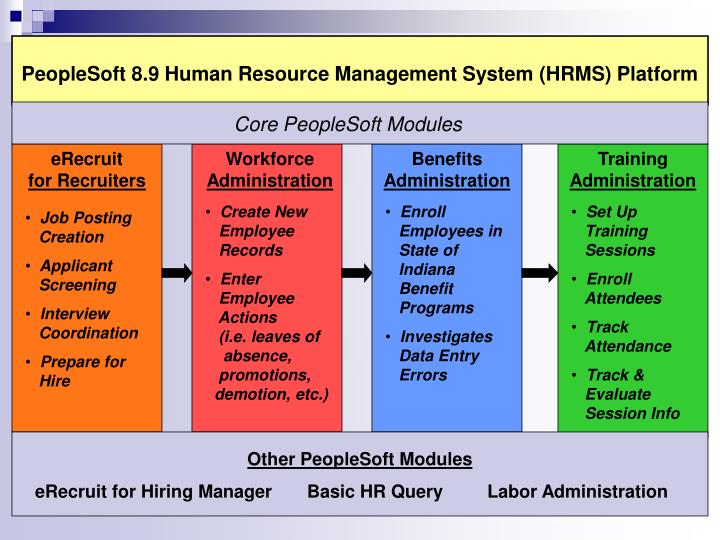
Thus PeopleSoft EnterpriseOne became JD Edwards EnterpriseOne and PeopleSoft World became JD Edwards World. Oracle moved to capitalize on the perceived strong brand loyalty within the JD Edwards user community by rebranding former JD Edwards products.

A month after the acquisition of PeopleSoft, Oracle cut over half of PeopleSoft's workforce, laying off 6,000 of PeopleSoft's 11,000 employees.

In December 2004, Oracle announced that it had signed a definitive merger agreement to acquire PeopleSoft for approximately $10.3 billion. Although Oracle had reduced its offer to $7.7 billion in May, it again raised its bid in November to $9.4 billion. In October, the same decision was handed down by the European Commission. Federal judge, who found that the Justice Department had not proven its antitrust case. In September 2004, the suit was rejected by a U.S. Department of Justice filed suit to block Oracle, on the grounds that the acquisition would break antitrust laws. Complicating Oracle's takeover attempt was PeopleSoft's poison pill, allowing their customers to potentially receive refunds of 2–5 times the amount they had paid in the case of a takeover. In February 2004, Oracle decreased their bid to approximately $9.4 billion this offer was also rejected by PeopleSoft's board of directors. In June 2003, Oracle made a $13 billion bid in a hostile corporate takeover attempt. Oracle Corporation acquisition īeginning in 2003, Oracle began to maneuver for control of the PeopleSoft company. PeopleSoft branded the OneWorld product PeopleSoft EnterpriseOne.
#Peoplesoft hr software
JD Edwards' software used the Configurable Network Computing architecture, which shielded applications from both the operating system and the database back-end. The latter's similar product line, World and OneWorld, targeted mid-sized companies too small to benefit from PeopleSoft's applications. In 2003, PeopleSoft performed a friendly merger with smaller rival JD Edwards. PeopleSoft expanded its product range to include a financials module in 1992, distribution in 1994, and manufacturing in 1996 after the acquisition of Red Pepper. PeopleSoft version 1, released in the late 1989, : 18 was the first fully integrated, robust client–server HRMS application suite. from Norwest Venture Partners joined the Board of Directors. The company's sole venture backing came from IBM. It should not be confused with Integral Systems of Columbia, Maryland, a different company. He cofounded PeopleSoft after leaving Integral Systems which was also based in Walnut Creek. Duffield envisioned a client–server version of Integral Systems popular mainframe HRMS package. History įounded in 1987 by Ken Morris and David Duffield, PeopleSoft was originally headquartered in Walnut Creek, California, before moving to Pleasanton, California.

PeopleSoft Campus Solutions (CS) is a separate package developed as a student information system for colleges and universities. PeopleSoft Financial Management Solutions (FMS) and Supply Chain Management (SCM) are part of the same package, commonly known as Financials and Supply Chain Management (FSCM). The PeopleSoft name and product line are now marketed by Oracle. It existed as an independent corporation until its acquisition by Oracle Corporation in 2005. is a company that provides human resource management systems (HRMS), Financial Management Solutions (FMS), supply chain management (SCM), customer relationship management (CRM), and enterprise performance management (EPM) software, as well as software for manufacturing, and student administration to large corporations, governments, and organizations. The mission of the Healthcare Industry User Group (HIUG) is to advance the goals and interests of healthcare organizations and similarly aligned entities by enhancing the effective and efficient use of Oracle solutions.PeopleSoft, Inc. The Public Sector User Group is a national organization consisting of Public Sector entities (including State and Local Government agencies and utilities) that use application software from the Oracle. It also provides a unified and effective voice to Oracle on all issues involving the use of Oracle application software in the higher education community. The Higher Education User Group educates and advocates by sharing ideas, information, and experiences among its members.

This user-led, user-driven community helps Oracle customers achieve higher satisfaction with their Oracle product by leveraging education, networking, and advocacy. PeopleSoft’s official cross-industry, cross-product, global user group.


 0 kommentar(er)
0 kommentar(er)
